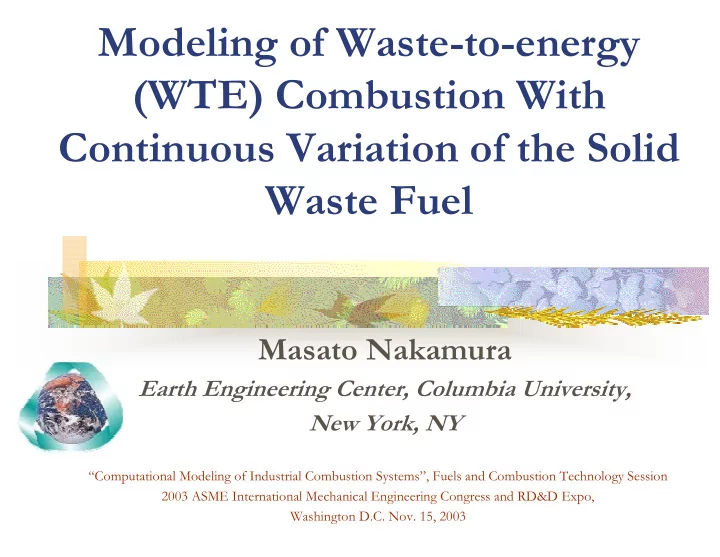

Modeling of Waste-to-energy (WTE) Combustion With Continuous Variation of the Solid Waste Fuel Masato Nakamura Earth Engineering Center, Columbia University, New York, NY “Computational Modeling of Industrial Combustion Systems”, Fuels and Combustion Technology Session 2003 ASME International Mechanical Engineering Congress and RD&D Expo, Washington D.C. Nov. 15, 2003
Overview � Background � Current problems � Objectives � Calculation methods � Results � Conclusions Mass-burn WTE 11/15/2003 Masato Nakamura
Schematic Diagram of the Reverse Acting Grate (Combustion Chamber) RB n : reciprocating bar (step) Inlet of Solid Waste FB n : fixed bar (step) FB 1 RB 1 26 o Outlet of Ash 11/15/2003 Masato Nakamura
Background Complexity of combustion process. � � Non-homogeneous municipal solid waste (MSW). � � Transient phenomena (channeling/break-up). � Unstable combustion caused by the inlet flow of � highly non-homogeneous MSW. � Unstable burnout point. � The lack of flow (& mixing) control. � � Incomplete combustion of solid waste. � 11/15/2003 Masato Nakamura
Current Problems Channeling of air flow through the grate results in � � A high excess air requirement (energy loss) � � Lowering temperature in the chamber � The relationship between fuel flow at inlet and � transient phenomena � Not fully understood � � Not included in existing WTE combustion models � 11/15/2003 Masato Nakamura
Objectives Understanding the effects of solid flow on transient phenomena and mixing mechanism during combustion processes on mass burn grates by: � Developing a mathematical model to characterize and quantify solid flow and mixing processes of the highly non-homogeneous MSW. � Simulating the behavior of solid waste particles that affects formation of channels and break-up. 11/15/2003 Masato Nakamura
Square Lattice Site Percolation Model Combustion Process Ash MSW at inlet (20% at outlet voids) on the traveling grate P=0.8 P=0.2 P=0.4 P=0.6 Occupation of burning particles � for different values of P Particles � Clusters � Paths � P=1.0 P=0 11/15/2003 Masato Nakamura
Channeling and Break-up of MSW in the Percolation Model on the Grate Particles -> Clusters -> Paths (a) Channeling (b) Break-up (Subsidence) 11/15/2003 Masato Nakamura
Calculation Methods Monte Carlo simulation for continuous variation of � MSW with percolation theory for transient phenomena (break-up and channeling of solid materials). Component of MSW in NYC. � � Paper 26.6 %, Cardboard 4.7%, Textiles 4.7%, Rubber&Leather 0.2%, Wood 2.2 %, Glass 5%, Metals 4.8% Other 4.6% and Plastic 8.9% ..etc. Matlab programming. � FLIC (Fluid Dynamic Incinerator Code) � Linux computer (CPU: 1.8MHz, memory: 256MB) with � VMware for Windows 98 environment. 11/15/2003 Masato Nakamura
Composition of 20 Random Samples Obtained by Monte Carlo Simulation 0.4 paper cardboard Component probablilty 0.3 plastic textiles rubber & leather 0.2 wood glass 0.1 metals other 0 0 5 10 15 20 Sample Number Time Series of Continuous Variation of MSW Components 11/15/2003 Masato Nakamura
Calculation Results of the MSW Combustion on the Reverse Acting Grate Result of percolation model for transient phenomena 11/15/2003 Masato Nakamura
Calculation Results of the MSW Combustion on the Reverse Acting Grate • Pv : Void Probability • Pc : Critical Probability • Pch : Channeling Probability • Pa : Ash Probability Voids 0 Transient phenomena during the combustion processes 11/15/2003 Masato Nakamura
Calculation Results of the MSW Combustion on the Reverse Acting Grate 1 Zone 8 Pa = 0.89 0.9 Pv : Void Combustion Probability Probability Zone 7 0.8 Pch = 0.75 0.7 Pc : Critical (Volume %) Zone 6 Pc = 0.59 Probability 0.6 Zone 5 0.5 Pch : Zone 4 Channeling 0.4 Zone 3 Probability 0.3 Zone 2 Zone 1 Pv = 0.2 Pa : Ash 0.2 Probability 0.1 0 1 2 3 4 5 6 7 8 Zone Number Inlet Outlet Combustion probability in the each zone 11/15/2003 Masato Nakamura
Conclusions The results obtained are promising and it is hoped to � gain a better understanding of the governing combustion and flow/mixing mechanism using the Monte Carlo method. The percolation model has identified the importance � of transient phenomena such as channeling and break- up of solid waste on the combustion process on the grate. The governing parameters such as void probability ( P v ), � channeling probability ( P ch ), critical probability ( p c ) , and ash probability ( p a ) were established by this model. 11/15/2003 Masato Nakamura
Acknowledgements � Prof. N. J. Themelis, Dr. H. Zhang and Dr. K. Millrath at Earth Engineering Center, Columbia University � The Earth Institute, Columbia University (funded as 2003 Spring Research Assistantship) � Waste-to-energy Research and Technology (WTERT) Council 11/15/2003 Masato Nakamura
Recommend
More recommend